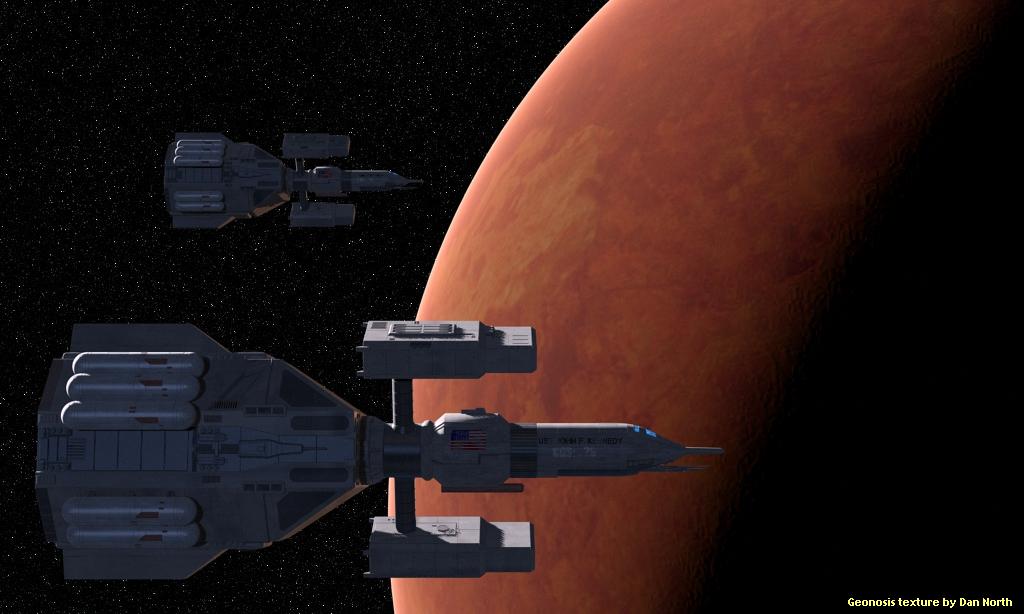
John F. Kennedy Class
Fast Missile Carrier
By Bryn Monnery,
Laurent Esmiol
and Mark Lucas
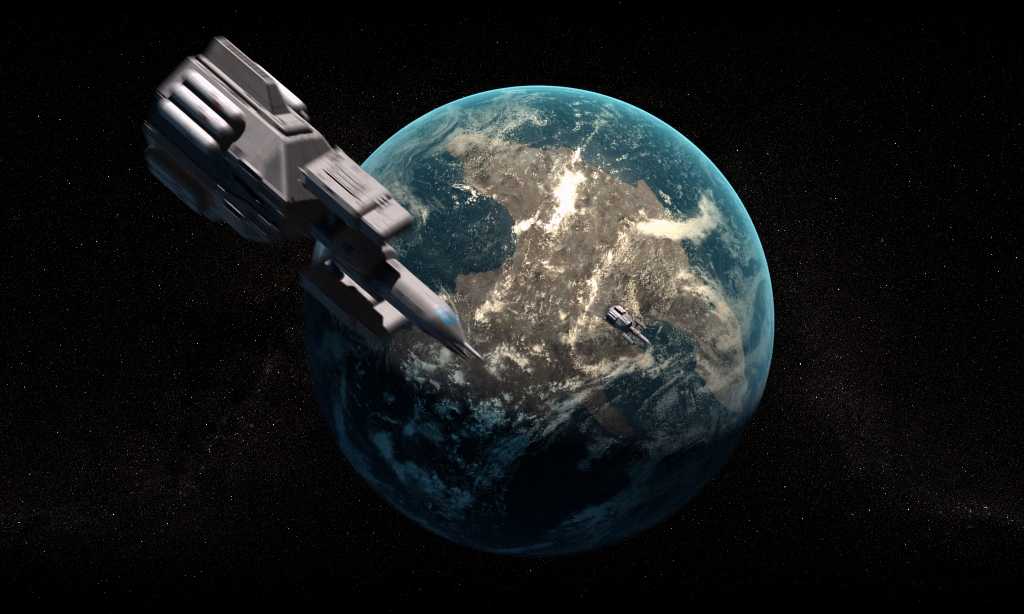
|
Above: Kennedy and Washington racing into blockade positions during Operation ENTENTE in the Kimanjano system (Reserve Fleet Media Ops)(Laurent Esmiol) Introduction The
Kennedys are some of the most glamorous
and controversial warships in service today. The mainstay of the United
States Space Force’s striking power. While classed by other nations as
a cruiser the American definition of Fast Missile Carrier reflects these
ships' design and operational concepts. Undoubtedly fast, stealthy and
with impressive firepower doubts remain as to the Kennedy’s staying
power when compared with ships such as the French Suffren.
Nevertheless they remain the pride of the USSF.
Acknowledgements This
article is based on the Kennedy class ship described in GDW's
1st Edition 2300 Referee’s Manual and Star Cruiser. The pictures in this
article are by Laurent Esmiol and Mark Lucas. Editing
by Dan Hebditch. Narrative Captain John Gsell raced to the bridge from his cabin, reliving the OOW on arrival. The display said it all. The sensor drone they had deployed on the edge of the system had given them vital early warning. ‘Relay the data to the squadron.’ He took a breath, ‘and to the Foudroyant and Schleswig. Request a video link with all their skippers.’ The screen told a worrying tale – three Bug battle cruisers and possibly over 60 missiles. Human forces in-system
amounted to his ship, the Reagan, a British destroyer, the three
frigates - one each from The human warships
began to maneuver, moving quickly away from Adlerhorst and out towards
the edge of the system. Defensive alerts were now sounding across orbit
and the world’s surface. One by one the multinational group of Captains
called in. As the final one joined Gsell had
made his decision and informed them of the plan that would take them into
battle.
Extract from Fast Ships: The USSF on the French Arm 2298-2303 (Colorado
Press, 2304)
|
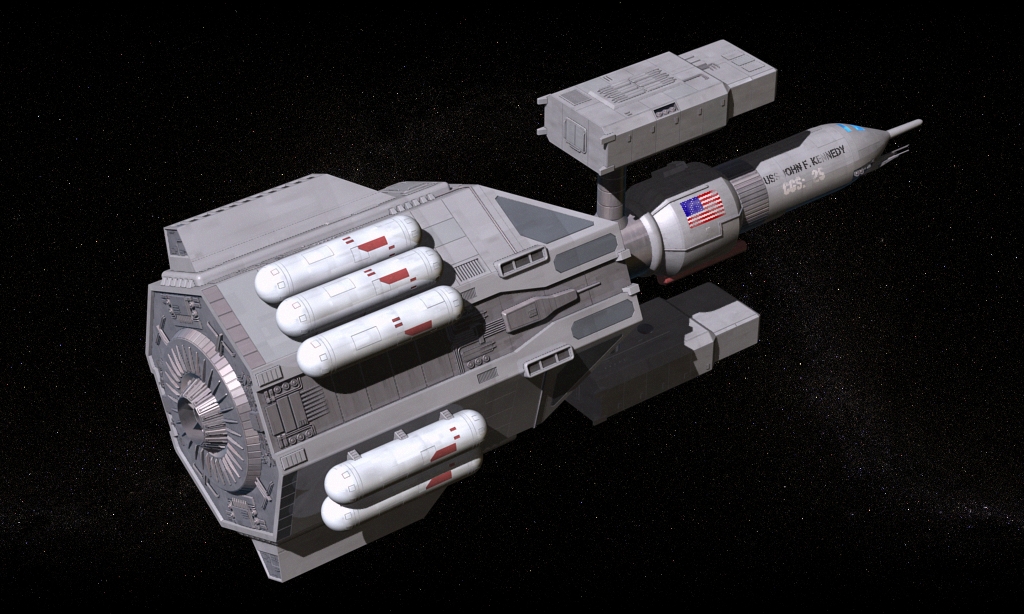
|
Above: Kennedy in the Sol system prior to the dispatch of CruDiv1 to the French Arm (USSF Information Command)(Laurent Esmiol) John
F. Kennedy class Fast Missile Carrier Hyde
Dynamics Model 14 "One-Mission Definite Kill" Semi-Independent
Missile Hyde
Dynamics Model 5 "Scout" Sensor Drone Historical Background However the invention of the |
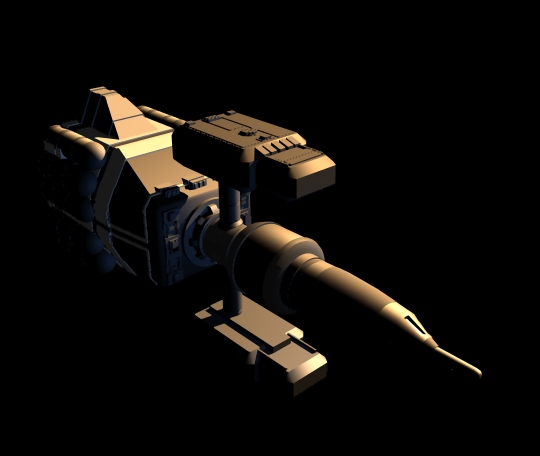
|
Above: Original concept design model of the Kennedy (USSF Procurement Command)(Mark Lucas) The Kennedy
has a fairly boxy hull profile based on work done by the French at the
time of her design. This is not intrinsically low RCS but it is composed
of some of the latest stealthy materials. She is 70 meters long, and 21
meters in diameter, displacing 12,350 cubic meters (approximately 900
tons of hydrogen). She has two extendible spin boom arms, each of which
carries spin quarters. The spin quarters are cramped for a starship
and many of the main facilities are in the zero-gravity parts of the vessel.
Gravity is maintained at .11G with the arms retracted but rotating during
routine operations. When out-system, where the larger profile doesn’t
matter, the arms are extended and gravity reaches .21G. The main engineering
is a 150MW TerraFuse fusion reactor with a life
span of 15 years. It powers the SAT The USSF mounted a concerted misinformation campaign in the late
2280’s and early 90’s, designed to make the world think that they had
many more ships than they actually did. Each ship was given multiple identities
and would routinely change hull names during voyages. It was duly reported
that the USSF had up to 20 of these vessels.
In fact in the time period concerned they had between 7 and 10. However,
with the Kafer War under way, the USSF has apparently
come clean, 9 Kennedys are in the USSF
Order of Battle as of Attritional vs Manoeuvre Warfare If executed successfully this tactic has proven very effectively. Kennedys cannot stand in the battle line as a conventional cruiser can, as much as US politicians would like them to, but they often act as ‘cavalry’ for Terran task forces; scouting, screening and providing vanguards and rearguards. Future designs will stress more armour and better survivability but for now the Kennedys’ excellent skippers make the most of the strengths of the design while doing their best to avoid potentially catastrophic close combat. |
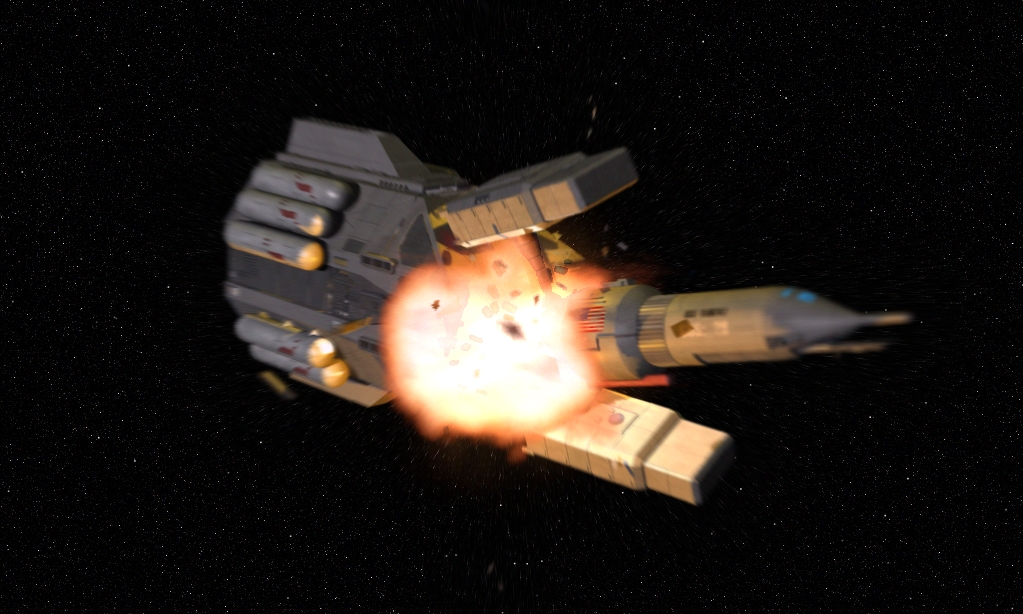
|
Above: The last seconds of the USS Sanchez in the Arcturus system as the crippled ship is scuttled. (USSF Information Command)(Laurent Esmiol) The USSF organises ships into semi-permanent units to aid the
development of team work. Each ‘Division’ usually consists of two ships,
although the loss of the Sanchez has meant that CruDiv2 is only
operating at half strength. CruDiv5 has detached the Reagan for
peacekeeping duties at Vogelheim
CruDiv1
After a considerable refit at Beowulf, Graham was ready to take the offensive, but divisions in command caused this plan to be aborted. Consequently CruDiv 1 was at Beowulf when the Kafers made their climatic attack. CruDiv1 was assigned to the newly formed TF Kennedy, reinforced with British and French destroyers, with Spence in command. They were assigned the unenviable task of disrupting the weaker Kafer fleet and keeping them from influencing the battle for as long as possible. However CruDiv1’s
operations were not over as they were re-armed and the Ultimately Kennedy
was involved in joint operations against the final Kafer stronghold
on the Eta Bootis finger at DM+36 2393. The Kennedy was joined
by the veteran Jefferson on the disbandment of CruDiv2 and was
part of TF29 during its operations against this system. Crew Quality: +2
(Kennedy), +4 (
CruDiv2 CruDiv2 was the first In this period Kafer
ships were constantly transiting the system. This made it very dangerous,
especially for ships near Aurore as the nearby FTL
shelf gave hardly any warning of attack. One transiting ship was successful
tagged back to the DM+18 2776 by the frigate USS Spitfire. After
several more unsuccessful probes of Hochbaden and Arcturus, the The major actions
of the Kafer War mainly moved into the Beta Canum Cluster until Christmas
Day 2301, when 16 Kafer ships of Task Force Victor under ‘Smasher
of Skull’entered the system and engaged Borodin’s Aurore fleet. They
were repulsed with the loss of 2 Betas and 2 Epsilons but the human fleet
was effectively finished with almost all their arms expended. However
they were saved by the arrival of the relief force on Less than a week
later the ‘Three Battles’ of Eta Bootis commenced, with major Kafer elements
closing on all sides in an attempt to smash the depleted defenders. The
first group was TF Victor, arriving on the 12th,
Borodin deployed his light forces in three successive lines falling back
while harassing the enemy until bringing his heavy ships up to finish
the job, sending The second group,
TF Whiskey was ambushed in the rings Laodaemon,
destroying the lead Delta Echo of Sorrow. Before the fleet could
pursue the broken Kafers the final group, TF
Yankee from Hochbaden arrived, and were eventually dealt with in a stand
up fight ending on 15 January. Aurore was effectively secured after seven
months of siege and Crew Quality: +4 CruDiv3 The CruDiv4 This division started
the Invasion divided. The Reagan was with the Vogelheim peacekeeping forces, while Things changed the
next month as the French 3e Flotte reinforced
with British and German Squadrons entered the system under the command
of Vice-Amiral Rochemont. News from Aurore had
reached him and he intended to launch a counterattack on Hochbaden with
the aim of relieving the Terran Forces at Eta
Bootis. His attack did not go well and he was forced to retreat from Hochbaden,
the Kafers mounting a pursuit which was defeated at Vogelheim
with the aid of the warships of the peacekeeping force. Crew Quality: +2
( |
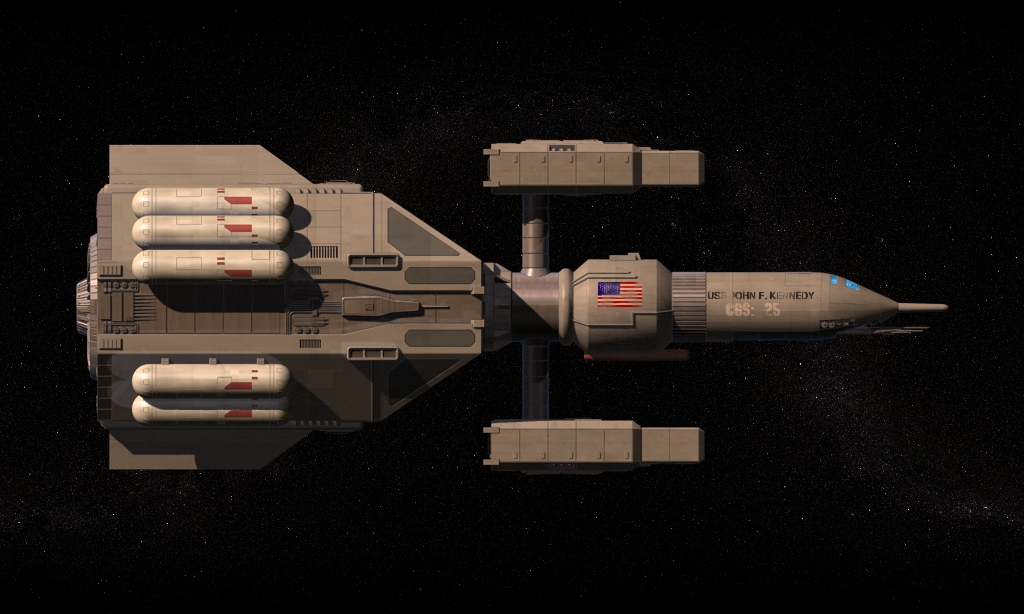
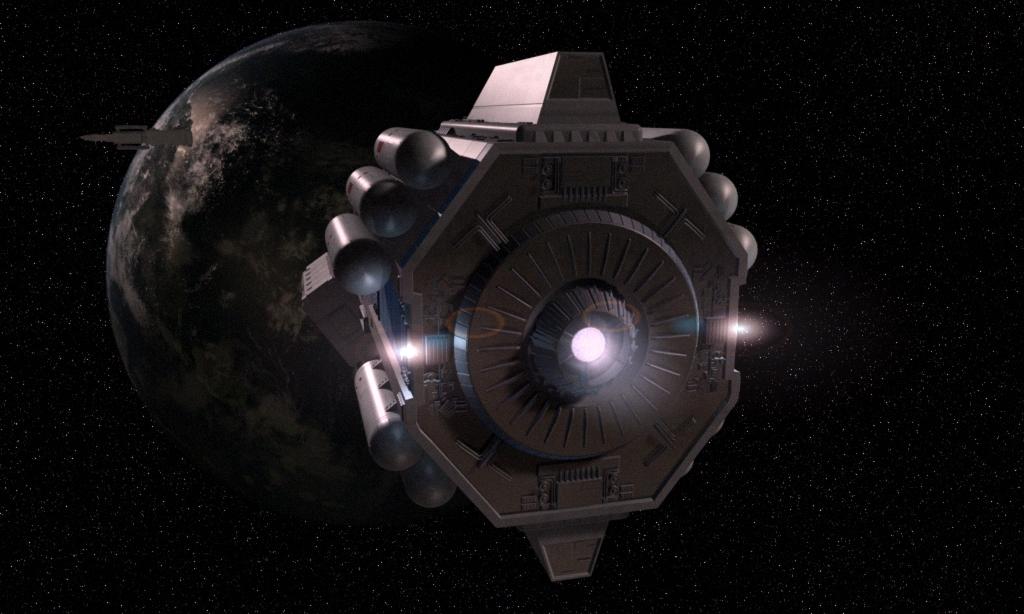
|
Above: The USS Reagan patrolling the Vogelheim system late in 2301. Note the presence of Rochemont's flagship Richelieu in-system. (USSF Information Command)(Laurent Esmiol)
Appendix
1
American
Hyde Dynamics SIM-14 Missile
Design
Date: 2279 First
Example Laid Down: 2279 First
Example Completed: 2280 Fleets
in Service: Number
in Service: 828
Combat
Performance Data
Movement:
7 Radiated
Signature: 1 Radial
Reflected Signature: 1 Lateral
Reflected Signature: 1 Radial
Target Profile: -4 Lateral
Target Profile: -4 Power
Plant Hits: 1/1 Armament:
one 10x2 detonation laser Active
Sensors: none Passive
Sensors: 8 Forward Looking (Folding)
Warp
Efficiency: 3.4 Power
Plant: 0.07 MW Fuel
Cell Fuel:
0.189 tons, sufficient for 8 hours of operation Mass:
10.4 tons Length:
14 meters Diameter:
1 meter Price:
MLv10.97 Bay
Volume/Mass: 14 cubic meters Appendix
2
Design
Date: 2288 First
Example Laid Down: 2288 First
Example Completed: 2289 Fleets
in Service: Number
in Service: 40
Movement:
9 Radiated
Signature: 4 Radial
Reflected Signature: 5 Lateral
Reflected Signature: 7 Radial
Target Profile: -3 Lateral
Target Profile: -2 Power
Plant Hits: 10/2 Armament:
none Active
Sensors: 13 Spherical Passive
Sensors: 10 (Folding)
Warp
Efficiency: 4.63 Power
Plant: 10MW MHD Turbine Fuel:
60 tons, sufficient for 10 hours of operation Mass:
270 tons Length:
10 meters Diameter:
6 meters Price:
MLv61 Bay
Volume/Mass: As vehicle, 1,680 cubic meters/ 336 tons of hangar
required for fast launch
Appendix
3
The
problem is, the Kennedy is actually a
slightly broken design as stands. The above statistics are based on the
Kennedy as presented in the Naval Architects Manual, with all the mistakes
corrected. |
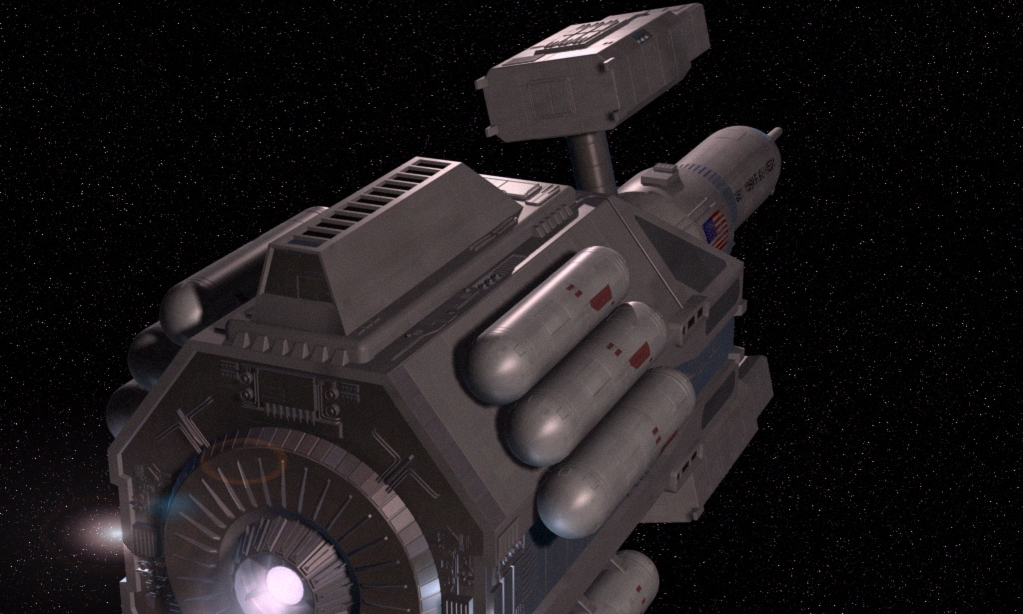
|
Above: A close up picture of the USS Kennedy in the QAS system in early 2302. (Reserve Fleet Media Ops)(Laurent Esmiol)
Appendix
4 Cayuga-class
Close Escort by Clare Hess; http://www.geocities.com/TimesSquare/Arcade/2303/mag/cayuga.htm American
Battleship Lone
Wolf by David Nilsen; http://www.geocities.com/TimesSquare/Arcade/2303/mag/lonewolf.htm 2300AD
Boxed Set Star
Cruiser Invasion Rear Admiral (Lower Half) Richard G. Spence USSF was strapped into his command station on the bridge of the USS John F. Kennedy, distantly daydreaming. CruDiv 1 was covering the approaches to Kimanjano from BCB while the bulk of the Task Group concentrated on lifting as many soldiers from the surface of Kimanjano as they could before they were overrun. ‘Sir, Confirm
Master contacts, designating one Alpha, one Beta, four Foxtrots as Master
1 to 6, confirming four more Master contacts, missiles sir, going for
our fighters.’ Extract
from ‘ENTENTE – The Miracle of Kimanjano’ ( Below: Another of the early images of the class. Some say that the second ship is just a manipulated image and that only one ship was in service at the time this picture was released. However due to the USSF's misinformation campaign the truth of this assertion has not been revealed. (USSF Information Command)(Laurent Esmiol) |
